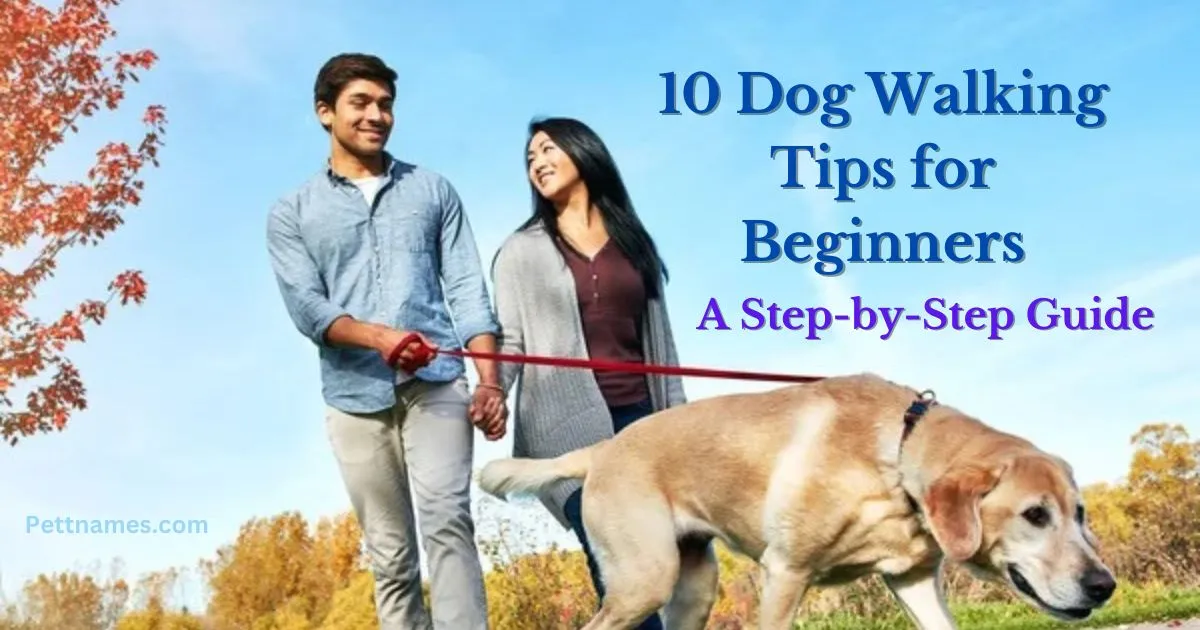Walking your dog is more than just a daily chore—it’s a bonding experience that keeps your furry friend happy and healthy. But if you’re new to dog ownership, it can feel overwhelming. Where do you start? This step-by-step guide covers essential 10 dog walking tips for beginners, helping you and your pup enjoy every stroll together. Whether you’re in the USA or anywhere else, these tips will turn you into a confident dog walker in no time. Let’s get started!

Why Dog Walking is Important for Beginners
Physical and Mental Benefits for Your Dog
Walking isn’t just about exercise. It helps your dog:
- Stay fit and maintain a healthy weight.
- Reduce anxiety and boredom, which can lead to destructive behavior.
- Improve digestion and overall well-being.
Building a Strong Bond with Your Pet
Walking together strengthens your relationship. It’s a chance to:
- Communicate and understand your dog’s needs.
- Build trust and establish yourself as the pack leader.
10 Dog Walking Tips for Beginners: A Step-by-Step Guide
Tip 1: Choose the Right Gear
The right gear makes all the difference. Invest in:
- A comfortable collar or harness that fits well.
- A durable leash (4-6 feet is ideal for beginners).
- Pro Tip: Look for reflective gear if you walk at night.
Tip 2: Start with Short Walks
If you’re new to dog walking, start small:
- Begin with 10-15 minute walks and gradually increase the duration.
- This helps your dog build stamina without overexertion.
Tip 3: Practice Leash Training
Teach your dog to walk politely on a leash:
- Use positive reinforcement (treats or praise) when they walk beside you.
- Avoid pulling on the leash—instead, stop walking and wait for your dog to calm down.
Tip 4: Pick the Right Time and Route
Choose a time and place that’s comfortable for both of you:
- Avoid peak heat hours in summer or icy paths in winter.
- Start with quiet, familiar routes to reduce distractions.
Tip 5: Use Positive Reinforcement
Reward good behavior to encourage your dog:
- Give treats or verbal praise when they walk calmly or follow commands.
- Keep treats small and easy to carry during walks.
Tip 6: Be Aware of Your Surroundings
Stay alert to keep your dog safe:
- Watch out for traffic, aggressive dogs, or toxic plants.
- Keep your dog on a leash in unfamiliar or busy areas.
Tip 7: Stay Consistent with Commands
Use simple, clear commands to guide your dog:
- Commands like “heel,” “stop,” or “leave it” can make walks smoother.
- Be consistent with your words and tone.
Tip 8: Socialize Your Dog Gradually
Introduce your dog to new experiences slowly:
- Let them meet other dogs or people in a controlled environment.
- Avoid overwhelming them with too much at once.
Tip 9: Monitor Your Dog’s Energy Levels
Pay attention to your dog’s behavior:
- Signs of tiredness include slowing down, panting heavily, or lying down.
- Adjust the walk length or pace based on their energy levels.
Tip 10: Make It Fun for Both of You
Keep walks enjoyable:
- Incorporate playtime or explore new trails.
- Bring a toy or let your dog sniff around (it’s mental stimulation!).
you may also like:
Top 50 Cute and Popular Pet Names for Male and Female Puppies in 2025
Common Mistakes to Avoid as a Beginner
Using the Wrong Leash or Collar
A poorly fitted collar or heavy leash can make walking uncomfortable. Always choose gear that suits your dog’s size and breed.
Skipping Warm-Up or Cool-Down Time
Just like humans, dogs need time to warm up and cool down. Start and end walks with a few minutes of slow walking.
Ignoring Your Dog’s Body Language
Your dog communicates through body language. If they seem anxious or tired, it’s time to head home.
Conclusion: 10 Dog Walking Tips for Beginners
Walking your dog doesn’t have to be stressful—even for beginners. By following these 10 dog walking tips, you’ll create a positive experience for both you and your furry friend. Remember, every great dog walker started as a beginner. So grab that leash, head outside, and enjoy the journey together!
Got questions or tips of your own? Share them in the comments below or tag us in your dog walking adventures on social media!
Read also:
How to Crate Train a Puppy in 7 Easy Steps: A Guide for New Owners
FAQs for “10 Dog Walking Tips for Beginners: A Step-by-Step Guide”
If you’re new to dog walking, you probably have a lot of questions. Don’t worry—we’ve got you covered! Here are the top 10 FAQs about dog walking for beginners, along with clear, actionable answers to help you and your pup enjoy every walk.
1. How long should I walk my dog as a beginner?
Answer:
Start with 10-15 minute walks and gradually increase the duration as your dog builds stamina. Smaller breeds or puppies may need shorter walks, while larger, high-energy breeds can handle longer walks over time. Always monitor your dog’s energy levels to avoid overexertion.
2. What’s the best leash for beginner dog walking?
Answer:
A 4-6 foot leash made of nylon or leather is ideal for beginners. Avoid retractable leashes, as they can be harder to control. For dogs that pull, consider a front-clip harness to discourage pulling and make walks more comfortable.
3. How do I stop my dog from pulling on the leash?
Answer:
Use positive reinforcement techniques:
- Stop walking when your dog pulls and wait for them to return to your side.
- Reward them with treats or praise when they walk calmly beside you.
- Consistency is key—practice daily to reinforce good behavior.
4. What are the best dog walking tips for small breeds?
Answer:
Small breeds have unique needs:
- Use a lightweight harness to avoid strain on their neck.
- Keep walks short and avoid rough terrain.
- Be cautious around larger dogs to prevent intimidation or injury.
5. How often should I walk my dog as a beginner?
Answer:
Most dogs need at least one walk per day, but high-energy breeds may require two or more. Puppies and senior dogs may need shorter, more frequent walks. Adjust based on your dog’s age, breed, and energy level.
6. What should I bring on a dog walk as a beginner?
Answer:
Always pack these essentials:
- Poop bags to clean up after your dog.
- Water and a portable bowl for hydration.
- Treats for training and rewards.
- A basic first-aid kit for emergencies.
7. How do I train my dog to walk beside me?
Answer:
Teach your dog to walk politely using these steps:
- Use a command like “heel” to signal walking beside you.
- Reward your dog with treats or praise when they stay close.
- Practice in a quiet area before moving to busier environments.
8. Are there specific tips for walking dogs in the city?
Answer:
City walks require extra caution:
- Use a shorter leash to keep your dog close in crowded areas.
- Avoid busy streets and opt for parks or quieter sidewalks.
- Be mindful of hot pavement in summer and icy paths in winter.
9. How do I socialize my dog during walks?
Answer:
Introduce your dog to new experiences gradually:
- Let them meet other dogs or people in a controlled setting.
- Reward calm behavior with treats or praise.
- Avoid overwhelming your dog—keep interactions short and positive.
10. What are common mistakes to avoid when walking a dog?
Answer:
Beginners often make these mistakes:
- Using the wrong leash or collar, which can cause discomfort.
- Skipping warm-up or cool-down time, leading to strain or injury.
- Ignoring your dog’s body language, which can result in stress or overexertion.
for more posts please visit our website pettnames.com
Read it:
Discover the Best Dog Kennels in Colorado Springs: Your Ultimate Guide to Pet Paradise!



